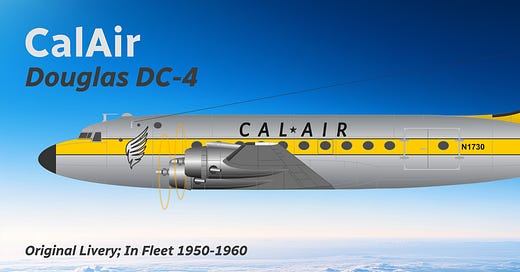Aircraft / Douglas DC-4
JStream Original Aircraft Template
The Douglas DC-4 is a four piston-engined, long range propeller-driven airliner manufactured by Douglas Aircraft Company, which was originally headquartered in Santa Monica, California USA, then relocated to Long Beach, California USA. In 1967 the Douglas Aircraft Company merged with St Louis-based McDonnell Aircraft Corporation to become McDonnell Douglas Corporation.
The DC-4 was designed in the late 1930s as a successor to an experimental Douglas aircraft, known as the Douglas DC-4E. Douglas kept the DC-4E’s tricycle landing gear, but implemented several design changes requested by US airlines. Among other things Douglas adopted a slightly smaller overall design and simplified fuselage, abandoned the DC-4E’s triple-tail design in favor of a larger single fin tail, and upgraded to more powerful Pratt & Whitney R-2000 Twin Wasp engines. The resulting product was rebranded as the Douglas DC-4A.
Douglas quickly sent the DC-4A into production at the onset of World War II, entering service with the US Army Air Force (USAAF) in 1942 as the Douglas C-54 Skymaster. Douglas Aircraft built a total of 1,170 C-54s across six variants at its assembly plants in Santa Monica, California and Chicago, Illinois.

An interesting side note: In 1945, a purpose-built Douglas C-54, the Douglas VC-54C, became the first official Air Force One aircraft - an aircraft dedicated to transporting the President of the United States. Although it was officially called The Flying White House, it became better known as the Sacred Cow, due to its special status and the high security surrounding operation of the aircraft. President Harry S. Truman signed the National Security Act of 1947, which officially created the US Air Force, while on board Sacred Cow.

In late 1945, several hundred C-54 aircraft were declared to be surplus, converted into civilian airliners, and resold to airlines around the world. The Douglas DC-4 quickly became the first aircraft type to provide proper modern, non-seaplane based transatlantic passenger air service. On 23-24 October 1945, American Export Airlines (AMEX) flew from New York to Bournemouth in Great Britain, via Gander and Shannon - LGA-YQX-SNN-BOH. (Bournemouth-BOH was replaced by London-LHR in May 1946.) Pan American Airways began offering its own transatlantic service a few days later. While the debut AMEX flight carried only 12 passengers, within five years over 300,000 passengers were making the crossing annually. By 1950 the flying boat was rendered obsolete.
Production of the DC-4 itself ended in 1947, having been superseded in favor of its larger sibling, the McDonnell Douglas DC-6 prop airliner. In later years many surviving DC-4s/C-54s were further modified to serve as freighters, air ambulances, civil firefighting equipment and air tankers until the late 1990s. As of 2024, two passenger DC-4s still remain active in South Africa serving as vintage and VIP air charters.
Reference: Wikipedia.
Stats
Stats displayed are for the Douglas DC-4D four-engined aircraft.
Name: Douglas DC-4D/Douglas C-54D
Origin: Santa Monica, California USA; Chicago, Illinois USA
Role: Four Piston Engine Propeller-Driven Airliner
First Flight: 14 February 1942
Status: Out of Production; In Very Limited Service
Cockpit Crew: Four
Seating: 44 day transport; 22 sleeper transport
Engines: 4 x Pratt & Whitney R-2000 Twin Wasp (Piston)
Cruise Speed: 197-214 knots (365-396 km/h; 227-246 mph)
Range: 2900 nmi (5300 km; 3300 mi)






